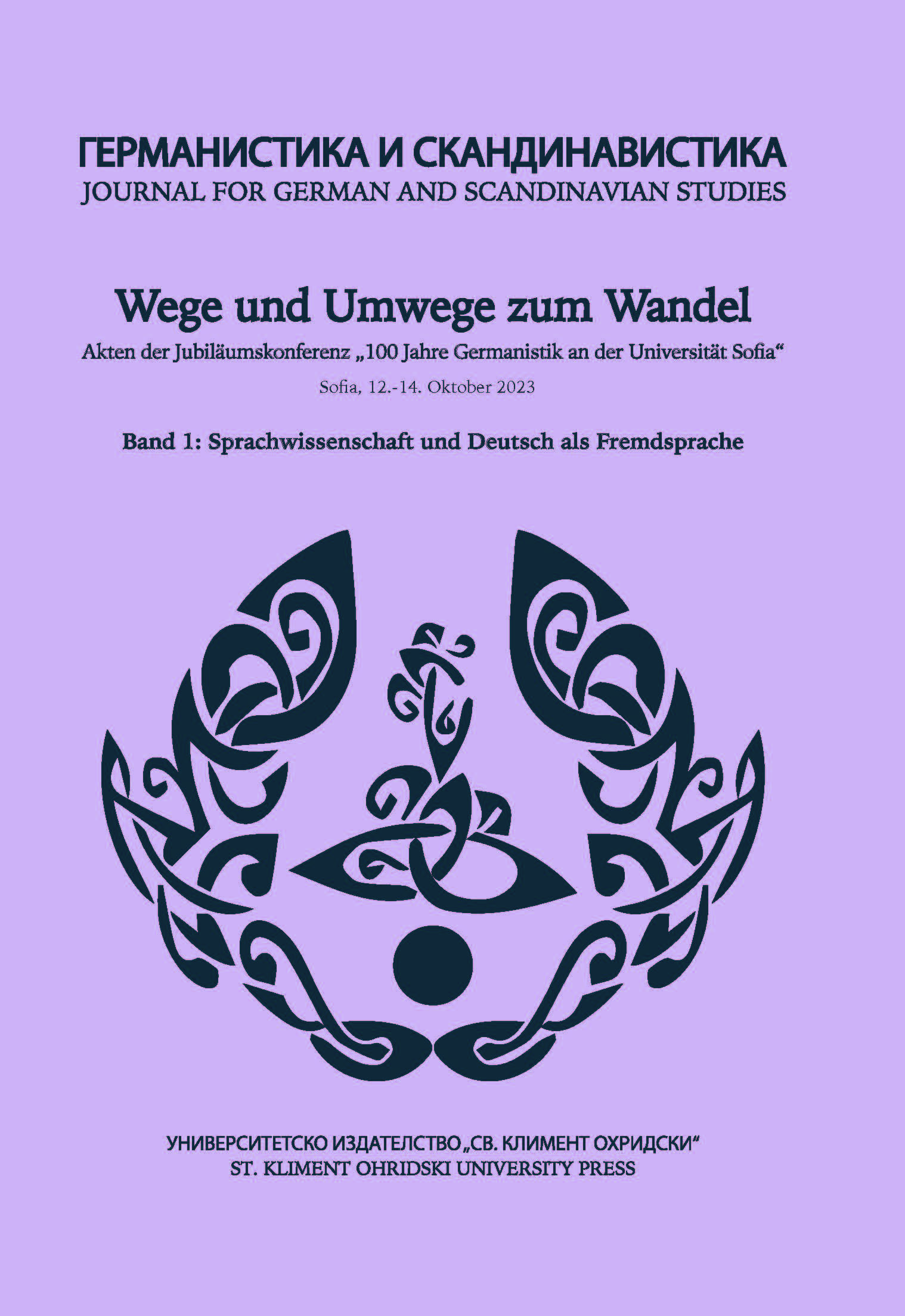Volumes
To download an article, click on its title.
Volume editors: Mikaela Petkova-Kessanlis, Radka Ivanova, Reneta Kileva-Stamenova, Svetlana Arnaudova, Maria Endreva
Publication date: April 24, 2025
ISSN: 2815-2867
Content (in German)
Foreword to the issue (in German)
Part 1: LINGUISTICS
Introduction to Part 1 (in German)
Mikaela Petkova-Kessanlis Sofia University St. Kliment Ohridski (Bulgaria)
GENRE CHANGE AS EXPRESSION AND PLACE OF ORIGIN OF CULTURE
Martin Luginbühl University of Basel (Switzerland)
INTERNET-MEMES AS DISCOURSE NARRATIVE TEXTUAL FORMS OF (RE-)TELLING ON THE INTERNET. A CHALLENGE FOR THE NOTIONS OF TEXT AND TEXT GENRE
Georg Weidacher Karl-Franzens-University Graz (Austria)
TEXT GENRE, COMMUNICATIVE GENRE OR MEDIA FORMAT? OLD WINE IN NEW BOTTLES?
Anna Hanus, Marta Smykala University of Rzeszów (Poland)
„BUCH“, „HÖRBUCH“, „E-BOOK“ & CO. LEXICAL CHANGE AND LEMMA UPDATE OF A GERMAN LEARNER´S DICTIONARY PORTAL
Zita Hollós Károli Gáspár University of the Reformed Church (Hungary)
ON THE CHANGE IN TEXT TYPE PROFILES IN THE VOSSISCHE ZEITUNG AND THE BERLINER ZEITUNG OVER THE LAST ONE HUNDRED YEARS
Hartmut Lenk University of Helsinki (Finnland)
AN IMPORTANT INNOVATION IN THE AREA OF ОLD HIGH GERMAN SYNTAX AND ITS GENESIS. OBSERVATIONS BASED ON THE OLD HIGH GERMAN TATIAN
Emilia Dentschewa Sofia University St. Kliment Ohridski (Bulgaria)
OFF-TEXTS IN TELEVISION REPORTAGES AS A VARIETY? CHARACTERISTICS OF A PROFESSIONAL TELEVISION LANGUAGE IN THE CONTEXT OF CURRENT CHANGES
Hans Gießen Saarland University, Saarbrücken (Germany), Jan Kochanowski University in Kielce (Poland)
LEXICAL DYNAMICS IN COVID-19 VACCINATION DISCOURSE: A CONTRASTIVE EMPIRICAL STUDY GERMAN/FRENCH
Hélène Vinckel-Roisin Université de Lorraine ATILF – Analyse et Traitement Informatique de la Langue Française [UMR 7118 – CNRS & UL] (France)
THE ACADEMIC OBITUARY – A TYPE OF TEXT IN A CHANGING STYLE?
Mikaela Petkova-Kessanlis Sofia University St. Kliment Ohridski (Bulgaria)
INFORMATION DENSITY AND THE PREDICTABILITY OF PHONETIC STRUCTURE
Bistra Andreeva, Bernd Möbius, Ivan Yuen, Omnia Ibrahim Saarland University (Germany)
EYECATCHER ON WEBSITES OF POLISH AND GERMAN PUBLIC NEWS PROGRAMMES – ON WAR-CENTERED REPORTING
Iwona Szwed University of Rzeszów (Poland)
RHETORICAL AND ARGUMENTATIVE MEANS IN THE GERMAN–POLISH DISCOURSE AHEAD OF THE 2023 POLISH PARLIAMENTARY ELECTIONS
Jarochna Dąbrowska-Burkhardt University of Zielona Góra (Poland)
Part 2: Deutsch als Fremdsprache
Introduction to Part 2
Radka Ivanova Sofia University St. Kliment Ochridski (Bulgaria)
(LITERATURE-)SCIENTIFIC CONTENT IN GERMAN AS A FOREIGN LANGUAGE-STUDIES – COMPATIBLE OR EXCLUSIVE?
Feruzan Gündogar Marmara University (Türkiye)
ON THE WAY TO PARTICIPATION CULTURALLY REFLECTIVE GFL-LESSONS THROUGH THE USE OF LITERATURE
Radka Ivanova Sofia University St. Kliment Ohridski (Bulgaria)
GERMAN LANGUAGE TEACHING AND SUSTAINABILITY – APPROACHING THEORY AND PRACTICE
Paul Voerkel, Xingyu Zhong Schmalkalden University for Applied Science & University of Jena (Germany)
DIGITAL TEACHING AND LEARNING METHODS IN LESSONS OF VOCATIONAL GERMAN AS A FOREIGN LANGUAGE
Maximilian Döhner Technical Universiy of Sofia (Bulgaria)
DIDACTIC CHANGE THROUGH PODCASTS IN FOREIGN LANGUAGE TEACHING – A STUDENT PROJECT
Jacqueline Dyballa Sofia University St. Kliment Ohridski (Bulgaria)
SCHOOL PRACTICES – ONLINE OR LIVE?
Yanka Koeva St. Cyril and St. Methodius Univeristy of Veliko Tarnovo (Bulgaria)
CIRCULAR MIGRATION AND LANGUAGE SKILLS IN GERMAN – A MULTILINGUAL SELF-LEARNING PORTFOLIO FOR LIVE-IN CARERS
Annegret Middeke Georg-August-University Göttingen (Germany)

